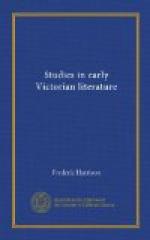A clever French woman said of George Eliot’s conversation—elle s’ecoute quand elle parle! Just so, as we read on we seem to see how she held up each sentence into the light as it fell from her pen, scrutinised it to see if some rarer phrase might not be compacted, some subtler thought excogitated. Of all the more important tales, Silas Marner is that wherein we least feel this excessive thoughtfulness. And thus it is the best. Perhaps other born romancers would have thrown into it more life, energy, jollity, or passion. Thackeray would have made the weaver a serio-comic hermit: Dickens would have made Eppie a sentimental angel; Charlotte Bronte would have curdled our blood; Trollope might have made more of Nancy’s courting. But no one of them could have given us a more lofty lesson “of the remedial influences of pure, natural, human relations.” The only doubt is, whether a novel is the medium for such lessons. On this, opinions are, and will remain, divided. The lesson and the art ought both to be faultless.
When we ask for a romance fully developed and more than a graceful vignette, Adam Bede must be regarded as the principal, and with the wider public it is always the typical, work of George Eliot. She said herself that it seemed to her “impossible that she should ever write anything so good and true again":—and herein she was no doubt right. It is the only one of her works in prose or verse which we feel to be inevitable, spontaneous, written out of the abundance of enjoyment and experience. It is of all her books the heartiest, the wittiest, the most cheerful, or rather the least desponding. In that book it may be that she exhausted herself and her own resources of observation as an eye-witness. She wrote fine things in other veins, in different scenes, and she conceived other characters and new situations. But for all practical purposes Adam Bede was the typical romance, which everything she had thought or known impelled her to write, in which she told the best of what she had seen and the most important of what she had to say. Had she never written anything but Adam Bede, she would have had a special place of her own in English romance:—and I am not sure that anything else which she produced very materially raised, enlarged, or qualified that place.




